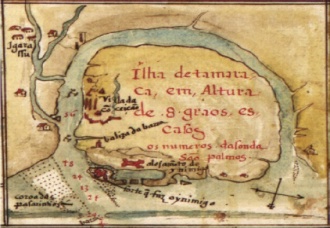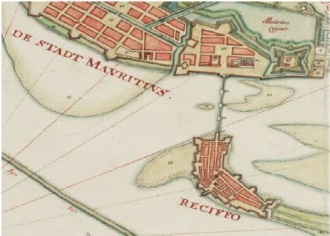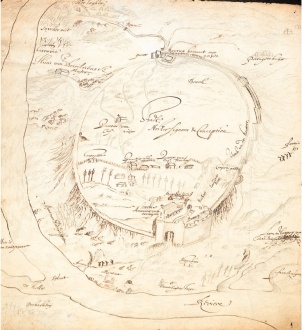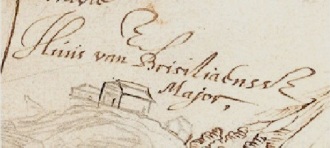 Detail of Vila Velha in 1637 – Frans Post.
Detail of Vila Velha in 1637 – Frans Post.The erudite and respected jewish historian Isaac Emmanuel was of the opinion that there was most likely an organised synagogue in Brazil in 1633/34, this conviction was based on the solid evidence of the purchase by Simon Drago of a Sepher Torah, (the holy scroll of jewish law), in Amsterdam on the 10th of June 1633. A Torah Scroll is essential in a synagogue, indeed a synagogue cannot exist without one.
Drago had been living in Brazil for several years as a New-Christian and the historian Emmanuel imagined that the destiny of the Sepher Torah was Recife where it would be used to found a synagogue given the religious tolerance of the Dutch Administration. The prolific brazilian historian José Antonio Gonsalves de Mello held Emmanuel’s opinion with such serious regard that he mentioned the hypothesis in his seminal work “Gente da Nação”, but also stating that they had not found any evidence of the scroll in Recife [1]……………. they were looking in the wrong place !
The Island of Itamaracá is a small island of 65 square kms. situated 50 kms. to the North of Recife in the State of Pernambuco, Brazil, and is connected to the mainland, since 1940, by a single 500 mt. long bridge. The village of Nossa Senhora da Conceição, today Vila Velha, is situated on a hilltop on the southern end of the island and is one of the first, if not the first, european settlements on the american continent, and has been continually populated for at least five hundred years. The village church is the oldest church in Brazil. The area was visited by Gonçalo Coelho and Americo Vespuccio in 1501 and 1503 in the course of their exploratory expeditions which were financed by Fernão de Loronha the wealthy portuguese new-christian financier, and personal friend of Dom Manuel, King of Portugal. In 1502 Loronha was awarded van exclusive crown contract for the exploitation of the resources of Brazil, principally the dyewood “Pau Brasil”,(Caesalpinia echinata), a tree native to Brazil which provided a strong red dye of high value and much in demand in Europe at that time. Interestingly, the wood is prized even today by the bow-makers of stringed musical instruments, and is known by them as “Pernambuco Wood”.
In the 17th. century, Brazil was twice invaded by the Dutch West Indies Company, (WIC), the first invasion in 1624 of the city of Salvador, Bahia was of short duration lasting only a year until 1625. The second invasion was in 1630, when the Dutch easily took the city of Olinda including the area that today is the city of Recife in Pernambuco.
Realising the strategic value of the island of Itamaracá the Dutch erected, in 1631, an adobe fort and palisade, Fort Orange, on a sand-bar at the southern entrance to the Canal Santa Cruz, the channel that separates the island from the mainland. Upon hearing of the arrival of the Dutch, Salvador Pinheiro mayor of Vila Velha, ordered earth defences to be raised around the village and had the hillsides surrounding the village made steeper to hinder the invaders, thus delaying the taking of Vila Velha until the 22nd. of May1633 when the village was overrun by the Dutch troops under the command of Sigismund Schkoppe, a German mercenary hired by the WIC. The Dutch remained in possession of the village until 1646 when an uprising by Portuguese Brazilians attacked and retook the village, forcing the Dutch to retire to their nearby Fort Orange, (2.5kms.), this situation continued until 1654 when the Dutch finally left Brazil.

Portuguese map of the island of Itamaracá – João Teixeira Albernaz 1640It is in this thirteen year period that we find evidence for a synagogue in Vila Velha or “Oppidum Schkoppe”, (Schkoppe City), as it was renamed by the Dutch. During the dutch occupation of Vila Velha the village had a resident Rabbi, Jacob Franco Lagarto, (Yahacob Franquo Lagarto), little is known of Rabbi Lagarto and I have been unable to find any alias that he may have used, although there is a suggestion that he was the son of one Simon Lagarto [2]. Egon Wolff, in an article published in the magazine, Menorah, states that Lagarto was the brother of the Hacham Mosseh Raphael de Aguylar, professor in the college Ets Haim in Amsterdam [3] There are multiple references to his having written a book of Talmudic Aphorisms – Tienda de Jacob (Ohel Yaacov or Jacob’s Tent), although no known copies are extant. He is also mentioned as Rabbi of Itamaracá in a poem by the famous “converso” poet Daniel Levi de Barrios. The author Jacob Nachbin claims that Lagarto organised the movement to colonize the far north of Brazil, the Guyanas and the Caribbean Islands on the occasion of the return of Dutch Brazil to the Portuguese in 1654 [4]. Another author, Simon Federbusch, suggests that he was “chief rabbi of all Jewish communities”[5].
The definitive proof of Rabbi Lagarto’s leadership of the jewish congregation in Itamaracá comes in his own handwriting, in an article, “Hooked On American Jewish History”, published in The Jewish Press in 2006 [6], the author, Dr. Yitzchok Levine mentions that in the Yosef Goldman Collection of American Jewish Books is a book in Hebrew titled “Shefa Tal” printed in Germany in 1612, which contains “a handwritten statement of ownership by a Rabbi Jacob Lugarto of a congregation in Tamarica, Brazil” !
Despite the scarce information about the life of Rabbi Lagarto, it is nown when and where he died, his grave is to be found in the Sephardi cemetery in Middleburg, Holland. His gravestone, number 24, is inscribed “DO BEM AVENTURADO HAHAM YAHACOB FRANQUO LAGARTO”, and the date of death as 8 Sebat 5427 (02 February 1667). [7]

The records of the Sephardi cemetery, (Bet-Haim), also provide us with some very important information…. the buyer in Amsterdam of the Sepher Torah, Simon Drago, also used the alias of Isaac Franco…… and is mentioned as the son-in-law of the Rabbi Lagarto ! [8]
This detail seems to have been overlooked by all the historians, the Sepher Torah was purchased in 1633 by an immediate relative of the Rabbi of Itamaracá !
Sadly the records also show the death of the Rabbi’s eight-month old granddaughter in 1640.
In January of 1634 orders came from the States General of Holland to allow religious freedom for all inhabitants in Dutch Brazil, many New-Christians, Conversos and Crypto-Jews returned to the open practice of Judaism. At that time, on the mainland some 70 kms to the North of Itamaracá in what is today the State of Paraiba, there lived a New-Christian by the name of Antonio Carvalho, (Jewish name – Isaac Nunes). As a young man in his native Portugal, Antonio had joined the Catholic Clergy and officiated as a chaplain in the University of Coimbra. In Brazil he lived opposite the Convent do Carmo and sang there in the choir in 1634, the exact date is not known, but Antonio abandoned Paraiba and moved with his family to Vila Velha in Itamaracá. [9]
In the same year, 1634, the famous jewish pirate, Moses Cohen Henriques, (the uncle of Jacob Cohen, the financial adviser and personal secretary to Count Maurice of Nassau), wrote a letter on the 9th February to the WIC in Amsterdam applying for permission to bring the first large organised group of Sephardi colonists to Brazil. The group arrived in 1635 and settled in Vila Velha on the island of Itamaracá. [10] If they came on one of Moses Cohen’s “pirate” ships which were smaller and more agile than the larger warships, and although there is no known passenger list for the group, an educated guess for their number would be between 100 and 200 souls.
From the details elaborated above we can see that there were present in Vila Velha in the early part of the period in question, the following; A Rabbi; Jacob Franco Lagarto, A Hazan (Cantor); Antonio Carvalho and a large group of Sephardim, amongst which there were certainly at least ten adult males, all the elements necessary for the formation of a Minyan!
If we add to this the possession of a recently purchased Sepher Torah and consider that even before the arrival of the Dutch and the advent of “religious tolerance” the Portuguese New-Christians risked their lives holding secret meetings in their homes to practice Jewish ritual, it is almost impossible to think that given the opportunity, a synagogue was not established.
It should also be mentioned that until the arrival of Count Maurice of Nassau in January of 1637, Itamaracá was the favoured place for the establishment of the capital of Dutch Brazil, the choice of Recife was a caprice of the Count and against the advice of such eminent councillors as Dr. Servaes Carpentier.
From The Minute Book discovered in Amsterdam in 1911 of the synagogues Zur Israel and Magen Abraham we know that these two congregations existed in Recife in 1648, Zur Israel in the original part of Recife and Magen Abraham in Mauricia, (Mauristaad), on the nearby island of Antonio Vaz. In 1649 the Mahamad, the Executive Commitee, of Zur Israel declared Magen Abraham to be under their aegis and central control, no other congregation in Brazil being recognised or permitted. Dr. Arnold Witznitzer, in his writings about this Minute Book, deduces that in 1648 there were no other congregations in Brazil, [11] while this is quite likely to be true it does not rule out the existence of other congregations prior to 1648, in fact the necessity of this arbitrary declaration by the Mahamad rather indicates that there had been. Could it be that Magen Abraham was founded by the previous congregation of Itamaracá after they were ousted from Vila Velha by the portuguese recovery of the village in 1646? Although the Dutch retained control of Fort Orange until 1654 it is unlikely that Jewish or Dutch civilians remained on the island. Dr. Wiznitzer also suggests that the tolerance shown by the Mahamad of Zur Israel towards the jews of Magen Abraham was due to the difficulty of access from Mauricia, (Antonio Vaz), to the synagogue Zur Israel in Recife [12]. A bridge connecting the island of Antonio Vaz to Recife was built by the New-Christian Balthazar de Fonseca and inaugurated in February of 1644, so visiting Zur Israel in 1648 did not present a problem.
 The bridge built by the New-Christian Baltazar de Fonseca, inaugurated in 1644.
The bridge built by the New-Christian Baltazar de Fonseca, inaugurated in 1644.Obviously all this evidence is of a circumstantial nature, now we will consider the possibility of the existence of physical evidence ………..

The above map can be found in the national archives in Holland,[13] it is in itself a mystery, the author is unknown and the annotations are in several languages, Italian, Dutch, Portuguese and French, and the information on it appears to be in the nature of “military intelligence”, showing the positions and numbers of soldiers, defences, officers names and their residences, sources of water etc.. Important information for the planning of an attack by the enemy. I believe this map was produced by spies in the Dutch camp, most probably Jesuit priests, they being versed in several languages, but it was intercepted by the Dutch, thus explaining how it came to be in their possession. This hypothesis is supported by a directive sent to Ippo Eisens, the dutch governor of Itamaracá, that came from the Herren 19, (Directors of the WIC), in Amsterdam on the 1st. of August 1635 ordering the expulsion of the Jesuits from Vila Velha. Examining the map it can be seen that the Dutch were cautious with their “allies”, the indians that sided with the invaders and fought with them against the Portuguese were quartered outside the protective walls of the village, as can be seen in the top left-hand corner of the map, where theyare referred to as “Brisiliaenses”.

In the top right-hand corner of the map we can see a group of buildings indicated as “Portugees huys”, Portuguese houses, I find it strange that the Dutch would allow some portuguese, ostensibly the enemy, to live so close to the village, unless, of course, they were considered to be allies. Due to the large number of New Christians in Brazil it was common practice at the time to refer to them simply as Portuguese, Portogalos or Portugals. I believe that the Dutch allowed them to live close enough to be under the protection of the 25 soldiers stationed nearby at the northern entrance to the village, but perhaps they were not trusted enough to be allowed residence inside the village walls.

After the Dutch definitively left Brazil in 1654, Vila Velha fell into decadence and has remained much as it was four centuries ago up to the present day, the lay-out and number of houses are almost exactly as they were.
If the hypothesis is correct, and there was indeed a synagogue in Vila Velha, then the area of the “portuguese” houses would be it’s most likely site, and the obvious area for an archaeological survey. At present the area in question is planted with widely spaced coconut palms, and lends itself admirably to an archaeological survey using
GPR (Ground Penetrating Radar), the quest being the discovery of a Mikvah, the ceremonial bath that is an essential part of Jewish religious ritual, and undeniable evidence of a synagogue.
There is some urgency if a survey is to take place, large tracts of land around the village have been bought by speculators and developers, and projects exist that propose construction in the exact area of interest.
Christopher Sellars. 31/05/2014.
christopher.sellars@gmail.com
Vila Velha,
Ilha de Itamaracá,
Pernambuco, Brazil.
[1] “Gente da Nação” – Page 231
José Antonio Gonsalves de Mello.
[2]. “A Odisseia dos Judeus de Recife” – 1979, Page 135.
Egon Wolff & Frieda Wolff.
[3] “Coletanea de Artigos e Conferencias” – IHGB-1991, Page 58.
[4] “Jacob Nachbin” – 1985, Page 249.
Prof. Nachman Falbel.
[5] “World Jewry Today” – 1959, Page 65.
Simon Federbusch.
[6] http://www.jewishpress.com/indepth/front-page/hooked-on-american-jewishhistory/
2006/12/06/
[7] http://www.zeeuwseankers.nl/nl-NL/media/scez_beeldbank-zeeuwsarchief_
HTAM-ALBUM-60-031
[8] Bet-Haim

[9] “As Comunidades Esquecidas” – 2002. Page 93.
José Alexandre Ribemboim.
[10] http://www.nljewgen.org/?s=300+JAAR+HANDEL+IN+SUIKER
[11], [12] “The Jewish Experience in Latin America” – 1971. Page 238.
Arnold Wiznitzer.
[13] http://www.atlasofmutualheritage.nl/nl/object/?id=8601













